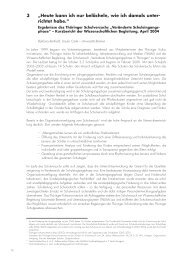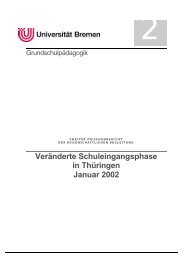-1- THE ELEMENTS OF A PROPOSAL Egon G. Guba A. Statement ...
-1- THE ELEMENTS OF A PROPOSAL Egon G. Guba A. Statement ...
-1- THE ELEMENTS OF A PROPOSAL Egon G. Guba A. Statement ...
You also want an ePaper? Increase the reach of your titles
YUMPU automatically turns print PDFs into web optimized ePapers that Google loves.
<strong>THE</strong> <strong>ELEMENTS</strong> <strong>OF</strong> A <strong>PROPOSAL</strong><br />
<strong>Egon</strong> G. <strong>Guba</strong><br />
A. <strong>Statement</strong> of the problem<br />
1. State the problem in terms intelligible to someone who is generally sophisticated but who is<br />
relatively uninformed in the area of the problem.<br />
2. Define and delimit the specific area of the research.<br />
3. Foreshadow the hypotheses to be tested or the questions to be raised.<br />
4. Indicate briefly the significance of the study (this item to be elaborated later).<br />
5. Be certain to include somewhere a sentence such as, "The purpose of this research is..."<br />
B. Review of Literature.<br />
1. Demonstrate to the reader that you have a comprehensive grasp of the field and are aware of<br />
important recent substantive and methodological developments.<br />
2. Delineate the "jumping off place" for your study" how will your study refine, revise, or extend<br />
what is now known?<br />
3. Avoid statements which imply that little has been done in the area or that what has been done<br />
is too extensive to permit easy summary. <strong>Statement</strong>s of this sort are usually taken (and often<br />
rightly) as indications that the proposer is not really familiar with the literature.<br />
C. Questions and/or Hypotheses<br />
1. Questions are relevant to normative or census type research. )How many of them are there?<br />
Is there a relationship between them?) Hypotheses are relevant to theoretical research, and<br />
when you state hypotheses the reader is entitled to have an exposition of the theory that lead<br />
to them (and the assumptions underlying the theory.)<br />
2. Hypotheses can be couched in four kinds of statements:<br />
a. Literary null: a "no difference" form in terms of theoretical constructs.<br />
b. Operational null: a "no difference" form in terms of the operations required to test the<br />
hypotheses.<br />
c. Literary alternative: a form that states the hypothesis you will accept if the null hypothesis<br />
is rejected, stated in terms of theoretical construction (this is usually what you hope the<br />
experiment will show).<br />
d. Operational alternative: similar to (c) except that the operations are specified.<br />
3. In general, you should be prepared to interpret any possible outcome with respect to the<br />
questions or hypotheses. It will be helpful if you visualize in your mind's eye the tables (or the<br />
summary devices) which you expect to come out of the research, short of the actual data.<br />
D. The Design<br />
1. Indicate the steps you will take to answer every question or to test every hypothesis indicated<br />
in the previous section.<br />
2. All research is plagued by the presence of confounding variables: the noise, as it were, that<br />
covers up the information you would like to have. Such confounding variables must either be<br />
eliminated by various kinds of controls, or be estimated and taken into account by<br />
randomization processes. Thus, in this section it will be proper for you to indicate:<br />
a. The variables you propose to control, and how you propose to control them, experimentally<br />
or statistically.<br />
-1-
. The variables you propose to randomize and the nature of the randomizing unit (pupils,<br />
grades, school, etc.)<br />
3. You should be aware of the possible sources of error to which your design exposes you. No<br />
one can expect of you that you will in every situation produce a perfect, errorless design.<br />
However, you can be expected to be aware of the possible sources of error and to do what you<br />
can to overcome them or to take them into account in your interpretation. To demonstrate this<br />
awareness, you should yourself point out the sources of error in this section.<br />
4. In discussion your design, it will be helpful if you can label it according to the terms of some<br />
logical or statistical typology. Such labeling is helpful in communicating your precise intention<br />
to the reader, and it also helps you to identify possible sources of error.<br />
E. Instrumentation<br />
1. In this section you should outline the instruments you propose to use. These should be<br />
describe if they are already available; if not, the procedures you will follow to develop or select<br />
the instruments should be described.<br />
2. Since the selection of instruments is in most cases also the operational definition of the<br />
variables, this is a most crucial step. It is at this level that a literary conception such as,<br />
"Intelligence is related to school achievement," becomes "Stanford-Binet I.Q. is related to<br />
Grade Point Average." Strictly speaking, any findings of your research will be relevant only to<br />
the instrumental or operational statement. You may adequately represent the variables<br />
contained in the conceptual statement of the problem. Of course, operational definitions are<br />
always arbitrary, but you should defend your particular brand of arbitrariness on some basis,<br />
even if none better are available than expedience, availability, or simplicity.<br />
3. In addition to the validity problem posed in (2), you should also be aware of questions of<br />
reliability and objectivity, and deal with these.<br />
F. Sampling<br />
1. The first reason for being concerned with sampling is that of external validity, i.e., knowing the<br />
population to whom the findings apply. To generalize validly the findings for a sample to some<br />
defined population requires that the sample shall have been drawn from that population<br />
according to one of several probability sampling plans. By a probability sample, we mean that<br />
the probability of inclusion in the sample of any element in the population must be given a<br />
priori (all probability samples involve the idea of random sampling at some stage). In<br />
experimentation, two distinct steps are involved:<br />
a. Random selection, i.e., the subjects to be included in the sample must all be chosen at<br />
random from he same population. You should define the population and indicate the<br />
sampling plan in detail.<br />
b. Random assignment, i.e., the subjects selected for the sample must be assigned at<br />
random to one of the experimental treatments. Subjects assigned to a group on the basis<br />
of some already existing basis, e.g. membership in boy scouts vs. no membership in boy<br />
scouts, ar not randomly assigned and hence the data are invalidated as experimental data,<br />
although not as study data (such studies are sometimes referred to as "ex post facto"<br />
experiments. You should indicate the assignment procedure you will use.<br />
2. The second reason for being concerned with sampling is that of internal validity. Without a<br />
probability sample we cannot construct an error estimate; hence, we have no way of telling<br />
whether the findings represent mere "noise" or whether they also contain information and, if so,<br />
in what proportion.<br />
G. Data Collection<br />
1. You should outline your general plans for collecting the necessary data, including an explicit<br />
statement covering the field controls you will employ. The major concern here is generally that<br />
you will maintain equivalent situations for all groups.<br />
-2-
2. You should give some idea of the time schedule you expect to follow, including any plans for<br />
counterbalancing to take care of order effects.<br />
H. Data Analysis<br />
1. You should specify the statistical and or other analytic procedures you will use. Where<br />
instrumentation remains to be developed it may not be possible to make a very specific<br />
statement in the absence of information regarding the strength of measurement, absence of<br />
information regarding the strength of measurement, continuity, form of distribution, etc, which<br />
may be expected.<br />
2. Develop "bogus" tables to indicate the nature of the analysis.<br />
3. Indicate briefly any special analytic tools you have available, e.g. IBM equipment.<br />
I. Significance<br />
1. Indicate how your research will refine, revise, or extend existing knowledge. Note that such<br />
refinements, revisions, or extensions may have either substantive or methodological<br />
significance.<br />
2. Almost all studies have two potential audiences: Practitioners and professional peers.<br />
<strong>Statement</strong>s relating the research to both groups are in order. (not necessary for Ph.D.<br />
dissertation.)<br />
3.* Indicate what the research means for your institution, e.g. it fits in with an institutional research<br />
program, it will contribute to renewed interest in research on the part of colleagues, etc. Very<br />
often grants are made as much on the basis of cultivating an institution as on the basis of<br />
intrinsic research merit.<br />
4.* Indicate what significance the research has in your own development and that of other<br />
members of the research team.<br />
J. The Budget<br />
1. Investigate the budget requirements of your own institution.<br />
2. Investigate the budget requirements of the granting agency.<br />
3. Do not overlook overhead items. (budget= $ + time)<br />
_______<br />
*These two items may properly be discussed in a cover letter if not in the proposal itself.<br />
-3-

















